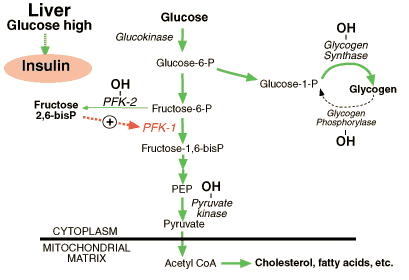
Carbohydrate Metabolism Regulation Problem Set
Question 3: PFK-1 Regulation in Liver
Tutorial to help answer the question
Given that the phosphofructokinase-1 (PFK-1) enzyme is regulated by insulin, but not via (de)phosphorylation, how is this regulation accomplished?
|
A.
|
Via increased transcription of the gene encoding this enzyme
|
|
B.
|
By recruitment of pre-existing enzyme from the Golgi
|
|
C.
|
Via allosteric regulation by fructose-2,6-bisphosphatase
|
|
D.
|
Activation by association with IRS-1
|
|
E.
|
An inhibitory subunit of the enzyme dissociates after binding cAMP
|
Tutorial
PFK-1 Regulation by PFK-2 in Liver
|

This regulatory loop is a liver specialty. PFK-2, which exists mainly in liver, is part of a bifunctional enzyme. In the presence of insulin, this activity is activated via dephosphorylation and produces small amounts of fructose-2,6-bisphosphate (note the correspondence between PFK-2 and F-2,6-bisP, vs.the more common enzyme PFK-1 and its product F-1,6-bisP).
Anyway, this small amount of F-2,6-bisP is enough to switch on PFK-1 in liver, leading to eventual conversion of glucose to pyruvate and thence to fatty acids, lipids and other goodies. Again, memorization of this whole scenario can be minimized (but unfortunately not eliminated) by always keeping in mind the purpose of insulin, namely to promote glucose uptake/storage. Or at least you could check yourself by remembering this.
|
![[Problem 3]](problem_3_left.gif) ![[Answer]](answer-2.gif) ![[Problem 4]](problem_4_right.gif)
![[MAINPAGE]](INTRODUCTION.gif) ![[Biochemistry]](biochemistry.gif) ![[Vocabulary]](vocabulary-1.gif) 
The Biology Project
The University of Arizona
March 16, 2000
Contact the Development Team
http://www.biology.arizona.edu
All contents copyright © 2000. All rights reserved.
|

